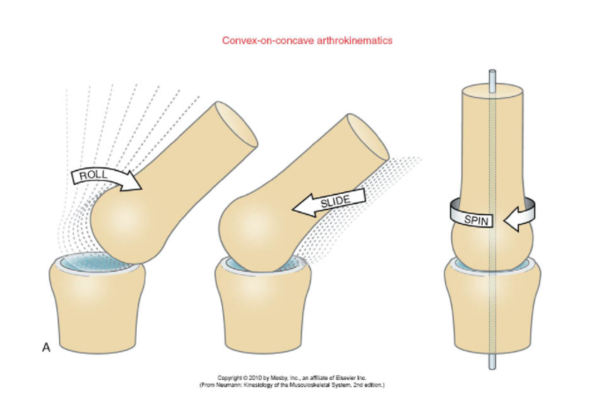Arthrokinematics: Difference between revisions
Kim Jackson (talk | contribs) m (Formatting) |
No edit summary |
||
| Line 6: | Line 6: | ||
== Introduction == | == Introduction == | ||
''''Arthrokinematics' '''refers to the movement of joint surfaces. | ''''Arthrokinematics' '''refers to the movement of joint surfaces. Arthrokinematics differs from [[Osteokinematics]] - in general Osteokinematics means bone movement and Arthrokinematics joint movement. | ||
The angular movement of bones in the human body occurs as a result of a combination of rolls, spins, and slides. | The angular movement of bones in the human body occurs as a result of a combination of rolls, spins, and slides. | ||
A '''roll '''is a rotary movement, one bone rolling on another. | # A '''roll '''is a rotary movement, one bone rolling on another. | ||
# A '''spin '''is a rotary movement, one body spinning on another. | |||
A '''spin '''is a rotary movement, one body spinning on another. | # A '''slide '''is a translatory movement, sliding of one joint surface over another. | ||
<gallery mode="nolines" widths="600" heights="600"> | |||
A '''slide '''is a translatory movement, sliding of one joint surface over another.< | File:Arthrokinematics.png | ||
</gallery> | |||
{{#ev:youtube|0cYal_hitz4}} | {{#ev:youtube|0cYal_hitz4}} | ||
<br> | <br> | ||
Revision as of 07:10, 4 May 2021
Original Editor - Justine Haroon
Top Contributors - Abdul Wajid, Justine Haroon, Admin, Lucinda hampton, Shaimaa Eldib, Claire Knott, Laura Ritchie, Ahmed M Diab, Tony Lowe, Kai A. Sigel, WikiSysop and Kim Jackson
Introduction[edit | edit source]
'Arthrokinematics' refers to the movement of joint surfaces. Arthrokinematics differs from Osteokinematics - in general Osteokinematics means bone movement and Arthrokinematics joint movement.
The angular movement of bones in the human body occurs as a result of a combination of rolls, spins, and slides.
- A roll is a rotary movement, one bone rolling on another.
- A spin is a rotary movement, one body spinning on another.
- A slide is a translatory movement, sliding of one joint surface over another.
The convex-concave rule is the basis for determining the direction of the mobilizing force when joint mobilization gliding techniques are used to increase a certain joint motion.
The direction in which sliding occurs depends on whether the moving surface is concave or convex.
Concave = hollowed or rounded inward
Convex = curved or rounded outward
If the moving joint surface is CONVEX, sliding is in the OPPOSITE direction of the angular movement of the bone.
If the moving joint surface is CONCAVE, sliding is in the SAME direction as the angular movement of the bone.
Examples:
- Glenohumeral articulation: concave glenoid fossa articulates with the convex humeral head
Glenohumeral posterior glide increases flexion and internal rotation
Glenohumeral anterior glide increases extension and external rotation
- Humeroradial articulation: convex capitulum articulates with the concave radial head
Dorsal or posterior glide of the head of radius increases elbow extension
Volar or anterior glide of the head of the radius increases elbow flexion
- Hip joint: concave acetabulum articulates with the convex femoral head
Hip posterior glide increases flexion and internal rotation
Hip anterior glide increases extension and external rotation
- Tibiofemoral articulation: concave tibial plateaus articulate on the convex femoral condyles
Tibiofemoral posterior glide increases flexion
Tibiofemoral anterior glide increases extension
- Talocrural joint: convex talus articulates with the concave mortise (tibia and fibula)
Talocrural dorsal or posterior glide increases dorsiflexion
Talocrural ventral or anterior glide increases plantarflexion
Resources[edit | edit source]
Kisner, C. & Colby, L.A. (2002). Therapeutic Exercise: Foundations and Techniques, 5th ed. F.A. Davis: Philadelphia.
References[edit | edit source]
References will automatically be added here, see adding references tutorial.








